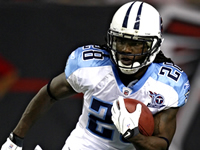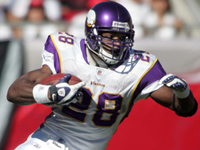8/24/10
So, through the tried and true approach of random number generating
you’ve been awarded the first overall pick in your fantasy league,
but who do you choose? It’s pretty rare that one player is seen
as the only option at #1; usually there are at least two guys you
could go with. This year those two are Adrian
Peterson of the Minnesota Vikings and Chris
Johnson of the Tennessee Titans. Please, please, no hate mail
arguing the attributes of Ray
Rice or Maurice
Jones-Drew or whoever else. Those backs may very well fit your
league’s top pick best, but, for the sake of argument, we’re going
with the most obvious top two choices for the majority of leagues
out there.
So which one will it be? How do you decide? To help you out we’ve
done some comparison work, reviewed both recent and career statistics,
and taken into account other elements like contract status, health,
off-the-field problems, and supporting cast and team personnel.
By identifying and analyzing these factors, hopefully we can make
the tough decision of which running back to take with your league’s
first overall pick a little easier.
Following is a head-to-head statistical comparison between the two:
| 2009 |
| Player - Team |
Rush Yds |
Rush TDs |
Rec Yds |
Rec TDs |
Rec |
FPts |
| Adrian Peterson – MIN |
1,383 (5th) |
18 (1st) |
436 |
0 |
43 |
304 |
| Chris Johnson – TEN |
2,006 (1st) |
14 (3rd) |
503 |
2 |
50 |
363 |
|
| 2009 |
| Player - Team |
Rush Yds |
Rush TDs |
Rec Yds |
Rec TDs |
Rec |
FPts |
| Adrian Peterson – MIN |
1,760 |
10 |
125 |
0 |
21 |
256 |
| Chris Johnson – TEN |
1,228 |
9 |
260 |
1 |
43 |
223 |
|
| Careers (Peterson
was a rookie in 2007, Johnson was a rookie in 2008) |
| Player - Team |
Rush Yds |
Rush TDs |
Rec Yds |
Rec TDs |
Rec |
FPts |
| Adrian Peterson – MIN |
4,484 |
40 |
829 |
1 |
83 |
805 |
| Chris Johnson – TEN |
3,234 |
23 |
763 |
3 |
93 |
586 |
|
In 2009 Peterson averaged a “measly” 4.4 yards per carry (ypc) while
the explosive Johnson averaged 5.6. Among starters or regularly
used backups, only Jamaal
Charles of the Chiefs and Felix
Jones of the Cowboys had a higher average (5.9 ypc) than Johnson.
Both backs get the ball about the same amount of time—22 carries
per game for Johnson and 20 per game for Peterson. However, Johnson
gets more receptions. He ranked 5th among all running backs and
led his team, while Peterson was 11th overall—one spot behind teammate
Chester
Taylor. Also, Johnson was 2nd in the league in receiving yards
by a running back (behind only Ray
Rice), while Peterson was 5th overall. Peterson also had a lot
more trouble holding on to the ball than Johnson did, doubling Johnson’s
fumbles total 6 to 3, and leading the league for starting running
backs.

Chris Johnson: A one-man show.
In 2009 the Titans ran the ball 499 times while throwing 476 times;
they became a running team (51% of the time), with quarterback Vince
Young still maturing and getting re-acquainted with the offense,
after a Week 6 benching of winless starter Kerry Collins gave Young
another chance.
In the Titans running game, Chris Johnson was a one-man show. His
backup, LenDale White, who had performed so well the year before,
was the only other back on the roster who played with any regularity
(Javon Ringer had eight total carries and Ahmard Hall had one carry
all year). Still, White averaged only four carries per game; the
Titans probably would have been better off letting Vince Young run
option plays instead of handing off to White.
This year’s running game looks to be shaping up as it did
last year, with Johnson playing virtually every snap and getting
all the yards, touchdowns, and fantasy points. The only changes
are at running backs coach and backup runners. Last year’s
coach was replaced by Kennedy Pola—but really, how much can
a running backs coach help or hinder Johnson? The Titans got rid
of LenDale White during the offseason, so Johnson’s backup
will be second-year man Javon Ringer. This means Vince Young is
still the second-best run option the Titans have, but it also means
Ringer becomes a very valuable handcuff/backup in your draft.
For the Vikings, Peterson got 67% of the team’s rushes, a total
of 314 carries. Chester Taylor was the only other running back with
any action last year, with 94 carries for 338 yards and 1 TD. This
year I expect Peterson to increase his workload with the departure
of Chester Taylor to the rival Chicago Bears—if, that is, he can
hold onto the ball. Peterson’s main backup will likely be Ryan
Moats, but rookie Toby
Gerhart will see a significant chunk of backup play as well
and is the “sexier” handcuff/backup option for most owners.
Last year the Vikings ran the ball 467 times, but threw it 553 times,
a fairly even offensive distribution (54% passing, 46% ruishing).
With Favre back for another season, Peterson's numbers will remain
comparable to last year’s although with Sidney Rice out until
mid-season after undergoing hip surgery this week and Percy Harvin
battling migraines, it wouldn't take a great leap to think the Vikings
might lean on Peterson now more than ever.
Peterson has missed just two games since entering the league in
2007, so he’s proven to be durable—more durable than
many had expected. Johnson has missed just a single game since entering
the league in 2008. Neither have had off-the-field problems or any
character issues, so the discipline and durability categories are
a wash. Both have been chosen for Pro Bowls, received votes for
or won Player of the Year, and Johnson became just the 6th RB in
NFL history to rush for more than 2,000 yards in a season. That
last number brings us to the “following season” curse.
This happens when a player has a great season, then holds out for
a new contract, gets it, and never again reaches the performance
level that got him the raise (see fellow and former Titan “Fat
Albert” Haynesworth).
More importantly, you should be aware of the following season’s
statistics for the other five 2000-yard rushers. None of them even
made it to 1,500 yards (Barry Sanders, DET, 1998: 1,491 yards; Eric
Dickerson, STL, 1985: 1,234 yards) and a couple of them barely rushed
for 1,000 yards (Jamal Lewis, BAL, 2004: 1,006 yards; O.J. Simpson,
BUF, 1974: 1,125 yards), while one didn’t even get 500 yards
the following year (Terrell Davis, DEN, 1999: 211 yards [injury]).
What, after all that you still don’t know who to take with
the first overall pick? True, you could make an argument for either
one and, barring an injury, be pleased with the results. Heck, you
might as well just flip a coin, right? Not quite. Let’s summarize
the value of each player by reviewing their pros and cons:
| The Good and the
Bad |
| Player |
Pros |
Cons |
| Adrian
Peterson – MIN |
1. Healthy
2. Single backfield
starter (no RBBC threat)
3. Explosive offense |
1. Fumbling issues
2. Uncertainty at WR position
3. Balanced offense |
| Chris
Johnson – TEN |
1. Healthy
2. Single backfield
starter (no RBBC threat)
3. Run-oriented offense |
1. Unhappy over contract status
2. Coming off a 2,000+ yard rushing season
3. Only
proven weapon on the team |
|

Adrian Peterson: The number one overall
pick in fantasy football.
Okay, we’ve gone through all the important deciding factors and
now it’s time to call out the name of the #1 overall pick, and it
is… Adrian
Peterson! The pros listed above easily cancel each other out.
Comparing an explosive versus a run-oriented offense doesn’t help
us much in choosing a running back. It’s pretty even ground. As
for the cons, Peterson’s fumbling may give you pause and is a slightly
larger issue than Johnson’s unhappiness. However, Peterson is the
type to have worked all offseason on rectifying that, so I’m not
much concerned about fumbles. Cons 2 and 3 are where the real answer
lies. What may seem like good things on the surface to other owners
have been labeled cons here, and for good reason.
Peterson gets my nod over Johnson because I believe Johnson will
be worn out from last year’s extremely impressive campaign,
and teams will be more focused than ever on stopping him by stacking
the line and taking their chances on Vince Young throwing it downfield.
Even if Johnson’s contract issue is resolved before the season
starts, it’s going to have a negative effect on his performance.
Plus, Peterson has proven he can put up similar numbers with or
without Favre leading the offense, and while the offense was pretty
balanced last year, it might be a little more run-oriented this
year given the current wideout situation.
So that’s it. While no one is saying that Johnson isn’t
the better overall fantasy back, his exceptional 2009 campaign put
some extra wear on his tires and a target on his back. Even though
the difference between the fantasy standings of both backs is slim,
those two factors stand out. And it’s going to be tough for
Johnson to reproduce something close to last year’s stats
while overcoming the odds—odds that even three out of three
Hall of Famers couldn’t beat. That right there is all the
reason you should need to take Adrian Peterson over Chris Johnson
as the first overall pick in 2010.
|

